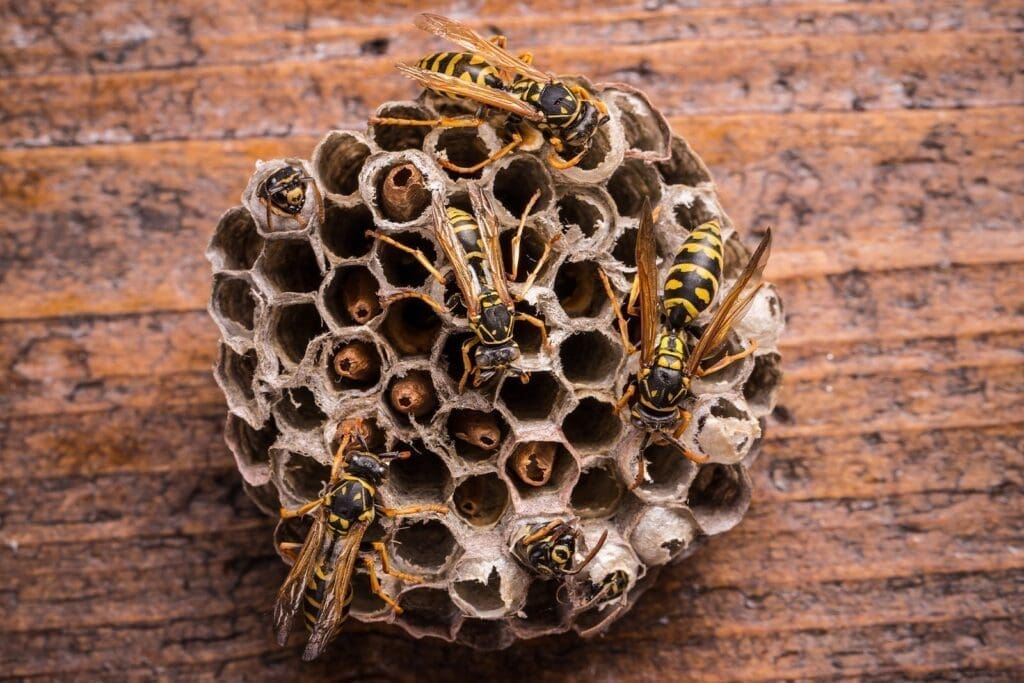
Pest Series: Wasps
As the warmer months roll in, so does the unwelcome buzz of wasps making their way into our homes. It's a common dilemma many of us face, leaving us wondering, "How are wasps getting in my house?" Understanding their sneaky entry points can be the key to keeping these buzzing intruders at bay.
Wasps are not only a nuisance but can also pose a threat to those with allergies. They're known for their persistence and clever ways of finding entry into our safe havens. In this article, we'll explore the common ways these winged pests make their way indoors and what we can do to prevent it. Let's dive into the world of wasps and reclaim our peace from these uninvited guests.
How to Know You Have A Wasp Infestation
Identifying a wasp infestation early on can save us a lot of trouble and potentially avoid unpleasant encounters with these stinging insects. Early detection is key to managing and resolving infestations effectively. Let's delve into some clear signs that can help us determine if we're dealing with a wasp invasion in our home.
Increased Wasp Activity
One of the most unmistakable signs of a wasp infestation is noticing an unusual increase in wasp activity around our property. This doesn't just mean seeing one or two wasps but rather observing a continuous presence or swarms flying in or around our home, especially during daylight hours when wasps are most active. If we spot wasps frequently hovering around a specific area or entering and exiting a hole in our home's structure, it's a strong indication that there's a nest nearby.
Nesting Sites
Wasps tend to build their nests in sheltered spots that offer protection from predators and harsh weather conditions. Common locations include eaves, attics, porches, and trees. If we notice any nests around our property, it's a clear sign that wasps have taken up residence. These nests can vary in size and shape, depending on the species, but most share a papery appearance due to the wood fiber wasps chew and mix with their saliva to create their nesting material.
Chewed Wood
Speaking of nesting material, another telltale sign of a wasp presence is finding Chewed Wood around our home. Paper wasps, in particular, are known for their habit of gathering wood fibers from sources like fence posts, garden furniture, and wood piles. They chew these fibers to create a pulp, which is then used to construct their nests. If we come across unexplained patches of bare wood or see wasps nibbling at wooden structures, it's likely they're gathering materials for their next home – possibly within ours.
By keeping an eye out for these indications, we can better understand and assess the situation, enabling us to take timely action against a wasp infestation.
Types of Wasp Infestation
When we notice an uneasy buzz around our homes, it's critical to pinpoint the exact nature of our uninvited guests. Types of wasps vary, and understanding which one has made your home their own can significantly impact our approach to dealing with them.
Yellow Jackets are notorious for their aggressive nature and preference for nesting in secluded, ground-level areas such as under porches or in hollow trees. Their presence is not only a nuisance but poses a significant health risk, especially to those with allergies.
Paper Wasps, on the other hand, take a slightly more elevated approach to home-building. They are commonly found in attics, eaves, and wall gaps, often choosing to nest in areas that offer them protection but are still close to the outdoors. Their nests, intricate and papery, are a sign of an established colony.
Another variety we might encounter is the Mud Dauber. Unlike their more aggressive cousins, Mud Daubers are relatively docile and prefer solitude. Their nests are easily identifiable: tubular mud structures attached to the sides of buildings, in garages, attics, or under the eaves. Despite their less aggressive nature, they're not a sight we want around our homes.
Here’s a quick rundown of where these wasps prefer to nest:
| Type of Wasp | Preferred Nesting Sites |
|---|---|
| Yellow Jacket | Hollow trees, under porches |
| Paper Wasps | Attics, wall gaps, eaves |
| Mud Daubers | Side of buildings, garages, attics, eaves |
Understanding the type of wasp infestation we're dealing with is the first step in taking back control of our homes. Each variety presents unique challenges, and knowledge of their nesting preferences is invaluable in forming an effective removal plan. Spotting these indicators early can save us a great deal of trouble, minimizing the potential for harm to our families and ourselves.
Common Entry Points for Wasps
When dealing with wasp infestations, it's crucial to understand how these pests are making their way into our homes. By identifying common entry points, we can take preventative measures to keep these unwelcome guests at bay. Let's delve into the primary areas wasps exploit to enter our living spaces.
Roof Openings
Roof openings are among the top culprits for wasp intrusions. These can range from loose or missing roof tiles to gaps around the eaves and flashing. Wasps are experts at navigating through these openings to find a suitable site for their nests, often choosing attic spaces for the seclusion and protection they offer. Regularly inspecting our roofs for damage and sealing any openings we find is a critical step in preventing wasp entry. Moreover, installing fine mesh screens over vents can help block access without impeding airflow.
Cracks and Gaps in Walls
The exterior walls of our homes can develop cracks and gaps over time due to weathering and natural wear and tear. Areas around windows, doors, and utility lines are particularly vulnerable. Even small openings are enough for wasps to pass through, making it essential to conduct a thorough inspection of our home's exterior. Applying caulk or expandable foam sealant to these cracks and gaps not only deters wasps but can also improve our home's energy efficiency. It's a win-win remedy that protects our homes from pests and the elements.
Chimneys and Vents
Chimneys and vents offer another gateway for wasps into our homes. These structures are designed to ventilate air out but can inadvertently invite wasps in if not properly covered. Bathroom exhaust vents, for example, can be a common entry point, especially if the exterior flap is damaged or missing. Equipping our chimneys and vents with well-fitting covers or screens is an effective strategy to prevent wasp access. We should opt for covers that allow smoke and air to exit while keeping wasps and other insects out.
By focusing on these common entry points, we position ourselves to better protect our homes from wasps. Regular maintenance and timely repairs are key to fortifying our defenses against these invasive pests.
Dangers of Having Wasps Indoors
Wasps entering our homes pose serious problems, not just as a nuisance but also due to the various dangers they bring with them. Understanding these risks helps us take the necessary steps to keep these pests at bay and ensure our homes remain safe and comfortable living spaces.
Health Risks
The presence of wasps indoors primarily poses significant health risks to us and our families. Firstly, wasp stings can be extremely painful and can result in several health issues. The most common reaction to a wasp sting is localized pain, swelling, and redness around the site of the sting. However, some individuals may experience severe allergic reactions, known as anaphylaxis, which requires immediate medical attention. Symptoms of anaphylaxis include difficulty breathing, swelling of the throat, hives, and a rapid drop in blood pressure.
Beyond the immediate physical dangers, the psychological impact should not be underestimated. Just the sheer presence of wasps can cause anxiety and stress, particularly in individuals with a known fear of insects or previous traumatic experiences with stings. Ensuring our homes are wasp-free is not just about physical well-being but also about maintaining a safe and stress-free environment.
Structural Damage
While wasps are not known to cause as much structural damage as other pests like termites, their nesting habits can still lead to problems in our homes. Wasps prefer to build their nests in sheltered spots, which means they often choose locations like attics, within wall cavities, or under eaves. If left undisturbed, these nests can grow significantly over time.
One of the key issues with wasp nests, especially those built within walls, is the potential for damage to the drywall or other materials as wasps continue to expand their nests. In extreme cases, large nests can weaken structural elements, leading to costly repairs.
Moreover, wasps can chew through various materials to gather nesting materials or to create entry points. This behavior can result in cosmetic damage to wood, insulation, and other materials that make up our homes. Regular inspections and preventative measures are critical in avoiding the hassles and expenses related to such damages.
Preventing Wasps from Entering Your Home
Discovering wasps inside your home can be an alarming experience. To prevent these unwelcome guests from getting inside, there are several effective strategies we can implement. Let's explore how regular inspections, sealing entry points, and using wasp deterrents can contribute to a wasp-free home.
Regular Inspections
One of the first steps in preventing wasp infestations is to conduct Regular Inspections of your home. Wasps tend to build nests in secluded areas such as attics, wall voids, and under eaves. By making it a habit to inspect these areas, we can catch any early signs of a nest or wasp activity. Look out for the following during inspections:
- Small openings or cracks in the exterior of your home
- Damaged window screens or open vents
- Signs of nest building, such as visible nests or an accumulation of wasp activity
Performing these inspections in the early spring can be particularly effective, as it's the time of year when wasps start to build their nests.
Sealing Entry Points
After identifying potential entry points during inspections, it's crucial to seal these areas up to prevent wasps from entering. Here's how we can do this effectively:
- Use caulking or expandable foam sealant to fill cracks and crevices on the exterior of your home.
- Repair or replace damaged window screens and vents to close off easy entry points.
- Check and maintain seals around doors and windows to ensure they're tight-fitting.
It's important to remember not to seal off a wasp nest inside your home. If a nest is found within the walls or attic, professional removal is necessary to avoid further complications.
Using Wasp Deterrents
In addition to physical barriers, there are several wasp deterrents we can employ to keep these pests at bay. Some of the most effective deterrents include:
- Peppermint oil: A natural repellent for wasps. Mix peppermint oil with water in a spray bottle and apply it around entry points and potential nest sites.
- Wasp traps: These can be purchased or made at home and placed around the perimeter of your property to capture wasps.
- Avoiding attractants: Ensure trash cans are sealed and food is not left out. Sweet substances and proteins can attract wasps to your property.
By incorporating these strategies, we can greatly reduce the chances of wasps making their way into our homes. Regular maintenance and vigilance are key to keeping these potentially dangerous insects at bay.
Conclusion
We've explored how wasps find their way into our homes and the steps we can take to prevent this. By staying vigilant with regular inspections and sealing any potential entry points, we're creating a barrier against these unwelcome guests. Incorporating natural deterrents and traps further ensures our homes remain wasp-free zones. Let's put these practices into action and enjoy a safer, more comfortable living space free of wasps.
Romex Pest Control has experienced staff, tens of thousands of 5-star reviews, as well as pet and child friendly products. Call 844-955-2447 for details.
Frequently Asked Questions
What happens if a wasp gets in my house?
If a lone wasp enters your home, it typically poses little danger. You can gently guide it out by coaxing it toward an open window or door, using slow movements to avoid provoking it.
How do you know if you have wasps in your walls?
Signs include hearing buzzing sounds, observing wasps entering/exiting through exterior cracks or holes, spotting nest materials in crevices, and noticing staining on walls from honey or droppings, which suggests a hidden nest.
What are wasps afraid of?
Wasps are deterred by citrus fruits, peppermint oil, and citronella oil, due to their strong scents which wasps find unappealing.
Can wasps come through vents?
Yes, external vents and ductwork provide an ideal, protected environment for wasps, thanks to their warmth, dampness, and darkness, facilitating wasp nest building and expansion.
How do you know if your house is infested with wasps?
Experiencing an increase in wasp activity around your home or spotting a nest indicates a wasp infestation. Often, professional help is needed to safely address the issue.
We hope you enjoy these informational articles. If you'd like to learn more about our eco-friendly pest control services, call (844) 955-2447.
Read More
Your Path to a Pest-Free Home or Business
Romex Pest Control
We are committed to protecting you, your children, and your pets with our eco-friendly, child-friendly, and pet-friendly guaranteed pest control solutions.
Romex Pest Control is fully insured and licensed in Texas, Oklahoma, Louisiana, and Mississippi.
Service Areas:
Hours
M-F 8 am–5 pm
Sat 8 am–2 pm
Sun Closed
Established 2016 © Copyright 2025 Romex Pest Control










